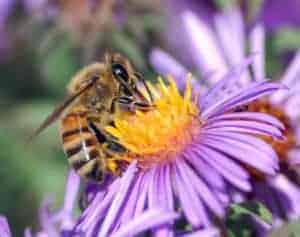For nectar, pollen and water, our bees will travel great distances
Honey bees are like foraging machines! While a single honey bee will make less than a teaspoon of honey in its lifetime, 60,000 bees in a colony all adds up to a lot of flying and gathering.

But just how far can a honey bee fly to gather those resources? The common answer is up to around 5 miles from the hive. But this would be the exception to the rule and likely only when closer resources are not available. The last thing you can call a honey bee is lazy. But, for the sake of efficiency, a typical foraging radius of 1-2 miles is more common, provided resources are available within this range. This range is still considerably greater than those of other bees, like mason and bumble bees, which prefer to forage within a few hundreds of yards of their home.
Honey isn’t the only thing bees seek, however. They’ll also head out from the hive to gather pollen for the hive, which they’ll store and feed to brood (developing bees) later. The hive also needs water, which they’ll bring back to the hive to cool the hive in summer and to dilute crystalized honey stores, if needed. Lastly, new queens leave the hive to find nearby drone congregation areas to mate and perpetuate the species.
The next time you see a honey bee foraging on a flower, pull up the map. That bee could be from a hive a mile away, or up to 5. Drawing a circle, you will see this is a huge area – tens of thousands of acres. This often debated, but is often stated as the reason why organic honey doesn’t exist in the United States, at least by a current government definition. No beekeeper can guarantee where and on what their bees will forage in such a huge area.
Honey bees are made to forage, and when it comes to gathering needed resources, the colony usually has an impressive foraging area at their disposal, to meet the needs of the colony.
